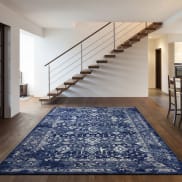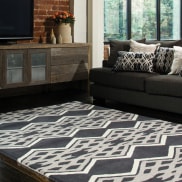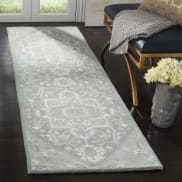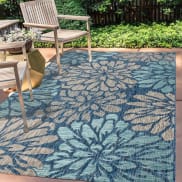The Best Guide to Rug Care At Home
Learn how to properly care for rugs and runners and avoid common problems.
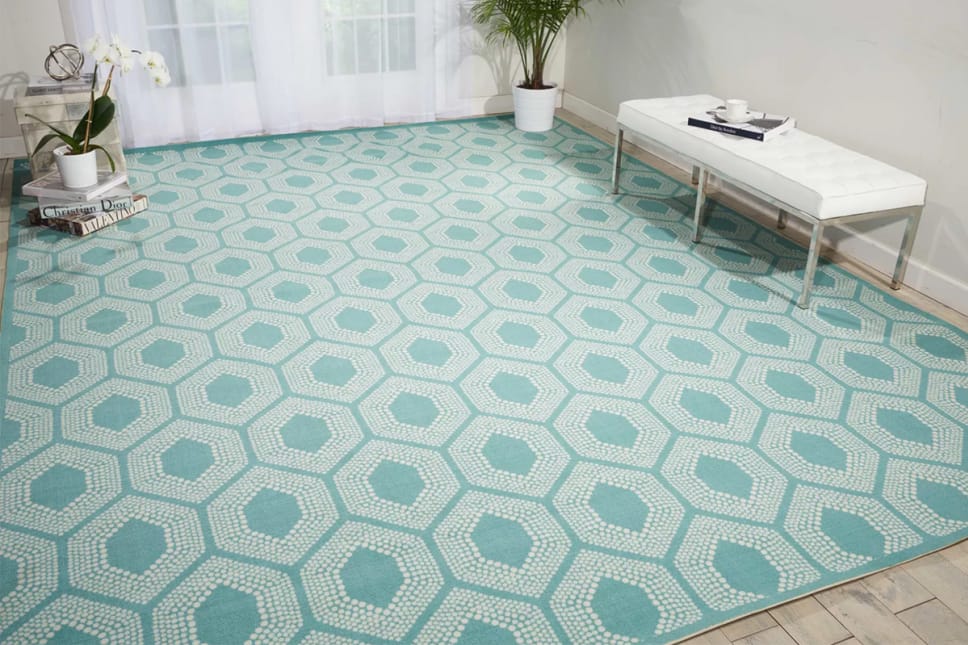
Rugs are designed to multitask. They provide comfort and warmth for bare and stocking feet, as well as add visual interest to any space. They can also effectively hide dust and light debris to keep the room looking tidy in between cleanings. Tapping into that bonus lifehack, however, is why regular care is so important to a long-lived rug, carpet, or hallway runner.
While rugs can help things look neat and clean, it’s important to remove dust and dirt rather than allow it to stay embedded in the fibers. Ignoring the mess on the rug can lead to permanent stains and odors, or deteriorate the fabrics over time. But not every rug can be cleaned using the same methods. The hardest part is finding the right remedy for each different kind of rug, because unique designs can pose unique challenges.

What Is it Made Of?
The first step in protecting that hard working rug, whether it is an off-the-shelf runner, or something with more of an investment behind it, is to know what it’s made of.
Wool
Wool fibers are naturally very absorbent and prone to fraying or shedding. This makes them more likely to stain, and any discoloration will transfer and spread easily. When vacuuming shag or wool, use a low vacuum setting, such as a handheld attachment wand, and turn off or remove the beater bar.
Sheepskin
Plush and luxurious, sheepskin rugs demand special care in order to keep their soft feel and rich color. The leather backing is durable but can be dried out by laundry detergents or soap. For stains, lightly dampen the area of the stain, and use cornstarch or potato starch as a means to soak up the spill. Let it dry completely and then shake the fur to remove the starch.
Natural Fiber
Jute, hemp, sisal, and seagrass are woven rugs that are very forgiving with dry debris and dust. Dirt falls through the weave and can be simply vacuumed away by lifting the rug. Wet spills require more care, however, as the fibers can mildew and break with too much moisture.
Synthetic Fiber
The coarse fibers of synthetic rugs can be chemically protected against stains, but it’s not always a guarantee. Be careful that the soaps you use to clean these rugs are color-safe.
Indoor/Outdoor
Designed to be durable, indoor/outdoor rugs can take a little more of a beating. They can be washed with color-safe dish soaps and blasted with a garden hose, so they can more easily stand up against the weather.

Problems to Look Out For
The obvious messes of a muddy paw print or the errant bread crumb are only the beginning. Regardless of the type of rug, there are multiple problem signs that can point to more damage if left untreated over time. If you notice the start of a problem, see to it quickly, and you’ll prolong the life of your investment.
Shedding
For rugs like wool rugs, some shedding or the random loose “sprout” here or there is normal, particularly if it is a new rug. To prevent excessive shedding of a new rug, try the following tips:
- Place the rug in a low-traffic area. The fewer feet trampling on it, the better the fibers will be able to settle.
- Trim any strands or loose tufts with scissors, do not pull them.
- When cleaning or grooming the rug, work with the pile of the carpet, not against it.
- During the first few months, vacuum the rug at least twice a week, using the lowest powered setting and without the beater bar.
- Use a carpet rake or carpet broom to groom the rug to gently work loose extra, unseated fibers.

Discoloration
For many types of rugs, color variations can be a natural part of the design. Handmade rugs often have a variance between different dye lots that can add to the unique character of the rug. Make sure you look over any rug purchase for those places where the colors might be stronger or lighter and take note of those areas going forward.
Depending on the type of rug and the quality, an early sign of the rug’s age may be fading or discoloration. Exposure to direct sunlight can cause sheepskin rugs to yellow and the dyes to fade in other rug types. Application of chemicals, or other liquid damage, even regular foot traffic, can wear the color quality down. Once a dye has faded, there’s not much that can be done, aside from taking it to a professional for cleaning or restoration.
Odor
The process of dyeing and binding rugs can involve chemicals that leave a lingering smell on the fibers. When they are then rolled and sealed for shipping and storage, the odor can have a bit of a baked-in effect. The odors should dissipate within a few weeks of use, but don’t hesitate to give a rug the sniff-test when making a purchase to be sure it is a smell you can handle.
Another common problem is moisture sinking into the threads and creating a musty scent to a rug, whether new or old and in use. The easiest treatment for refreshing a pungent rug can be sunlight and fresh air to make certain the damp and mildew smell is dried out.
- Hang the rug from a laundry line or fence railing on a clear day to allow airflow all around on both sides.
- Be careful not to leave the top surface in the sun for more than an hour or two at a time, to protect the colors from fading.
- If it must be laid flat, protect the surface with a sheet, and flip it over to expose just the back side after a few hours.
- It may take a few days of sunbathing to air out the smells, so bring the rug in at night to protect it from further moisture damage.
For stubborn odors, there’s a more drastic approach to try: kitty litter. The clay in clean, unscented kitty litter can absorb smells and moisture.
- Remove the rug to an area where it will not be in the way or walked on.
- Spread a layer of fresh, unscented kitty litter over the rug. The litter should be as chemical-free as possible, and be careful to keep it from grinding into the fibers.
- Let it set for a day or so to allow the clay to pull the offensive odors from the pile.
- Shake the rug off and vacuum the rug a few times. The odors and any remaining litter debris should vacuum away and leave you with a fresh rug.
Creases
Whether a living room rug or a hallway runner, rugs should lie flat. Creasing can crack and damage the backing, which can lead to accelerated deterioration of the fibers, as well as run the risk of trips and falls. A new rug may have creases from shipping, but they should settle out within a week or so.
If a crease is exceptionally stubborn, roll the rug in the reverse direction and let it sit overnight, or lay it flat on the side opposite the curl. Furniture or heavy books can be used to weight down the corners, but be careful not to over-stretch the rug when trying to flatten it.
Wear
As with any carpet, rugs can be worn thin in places from regular use. Walking traffic, pets, and even leaving furniture to sit on the rug can flatten the pile over time, separating and tearing the fibers or the backing. Depending on the quality of the rug, some rugs can be repaired once worn down.
- Carpet tape can be used for quick foundation or backing repairs.
- Never use a sewing machine to repair a handwoven rug, as it causes structural damage to the rug foundation and wears out the fibers in the pile.
- Edges can be braided and cut backing can be rewoven, if gotten to a professional restorer early, before too much damage has occurred.
If it’s worth repairing, it’s worth repairing correctly. When it comes to more expensive rugs, master-weavers and professional cleaning services will best ensure the value of your investment.

Keep In Mind
Whatever the rug and whatever the mess, there are a few more universal care tips to know.
- Always protect the rug and the floor with a rug pad. The padding reduces wear, keeps the rug held in place, and adds extra cushioning.
- Regular brushing or sweeping a rug with a carpet broom or sweeper can help keep the pile fresh on longer pile rugs and helps separate stubborn pet hair from the rug fibers.
- It’s a good idea to vacuum or shake out rugs once a week. This will keep them from collecting too much dirt and grime to avoid stretching and wearing out the fibers.
- Rotate the rug every six months or move it to a new location. This prevents “traffic patterns” from flattening and embedding the pile and ensures even wear.
- Rugs should not be used in overly humid areas without good ventilation. The settled moisture can ruin the rug foundation as well as build up mildew and grime.
- Do not expose a dyed rug to direct sunlight. The UV exposure and temperature variance adds to the fading of the colors. Sheepskin and wool fibers will yellow and may dry out or fray easier with too much sun.
- Stain-resist treatments, strong chemical cleaners, and bleach can deteriorate fibers and ruin dyes. Even those treatments that claim to be color-safe should be tested first on a small area before being used on the entire rug.
- Avoid running the vacuum along the edges of serged rugs or fringed rugs. The vacuum will pull the threads and could loosen the fibers or cause fraying in fringes, deteriorating the rug.
- Another cleaning trick is to shake out or hang a rug from an outdoor railing or fence, and then use a broom or rug beater to hit the back of the rug to remove excess dirt. Most rugs are durable enough that this is a useful option, but keep in mind the type of rug and the strength of the construction before taking out any weekly frustrations on the rug. The goal is to hit it just hard and quick enough to remove the dirt, while still leaving the fibers attached to the foundation.

How to Clean a Rug (The Basics)
The first rule of keeping a clean rug is to act quickly! Don’t let stains set. The less time the fibers are exposed to the dirt, the better the chances of getting it cleaned, so it’s best to start the clean-up right away.
Remove any furniture or other obstacles that might prevent easy access to the stain, or that might cause moisture to pool or puddle deeper into the carpet fibers.
Scrape up any excess food or other debris with a flat, dull edged tool, such as a dust pan.
When possible, vacuum first, but be careful not to grind the mess into the rug. This helps clean up the excess dirt or debris that may be in the way of a deeper cleaning.
Blot at stains with a clean cloth to soak up any excess liquid. Do not rub the stains into the pile. Rubbing the stains sends it deeper into the fibers and spreads any discoloration, making the stain bigger.
- Use a clean, undyed cloth or paper towel to apply cleaning solutions. Again, blot at the area to be treated, do not scrub.
- Any pre-conditioning solutions may be used after vacuuming and before deeper cleaning. They should be allowed to soak into some fibers at least 10 minutes.
- For most stains, cold water with dish soap will mix together into an effective, color-safe cleaning solution. Mix 1 cup water with a teaspoon of clear dish soap in a spray bottle, shake it up, and spray the stain.
- Never use harsh, scented soaps, laundry detergent, or dishwasher detergent. Look for cleaners with a low ph, between 5.0 and 8.0, or ph-neutral detergents. If the soaps are too strong, it won’t properly rinse from the fibers and can leave behind a tacky residue that collects grime and dirt.
Too much water or moisture can make things worse, so be careful not to use an excessive amount of water. Allow plenty of air circulation around the rug, and dry it hanging or draped if at all possible. Wait 12 to 24 hours before walking on a rug or placing furniture on it to be sure it is fully dry before use.
Once a rug has been cleaned and dried, vacuum it again to be sure all residual debris and loosened fibers are taken care of. If the rug is reversible, vacuum both sides to catch all grime build up.

It may seem tedious or inconsequential, because after all, it’s just a rug, and rugs are made to be walked on and get dirty. But maintaining a regular cleaning routine with the rugs and runners in your home can add years to the lifetime of use they can provide.

